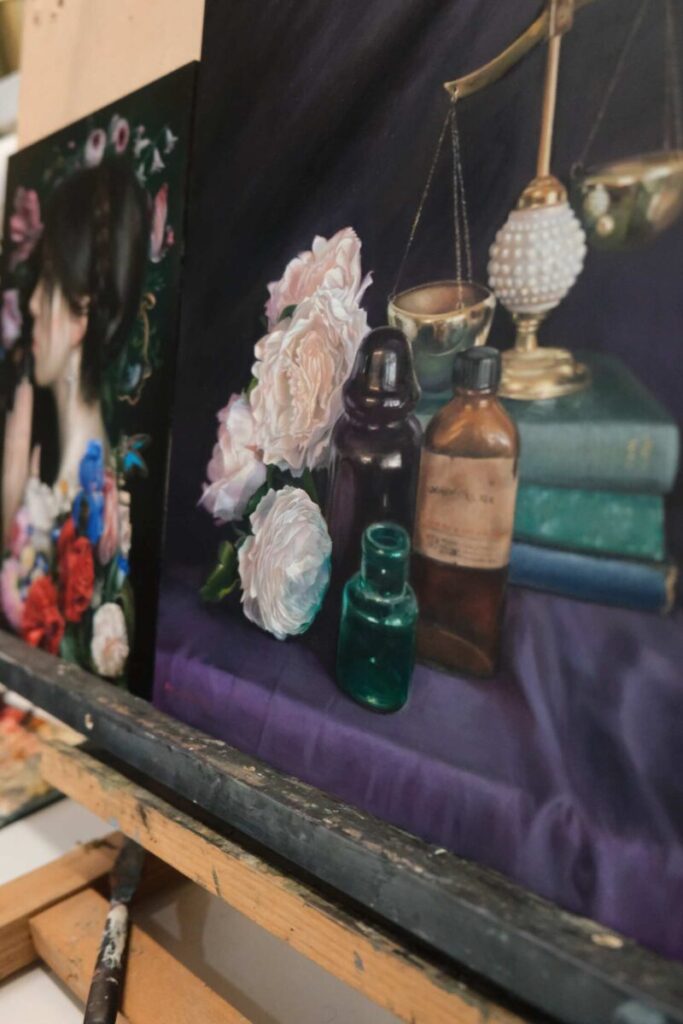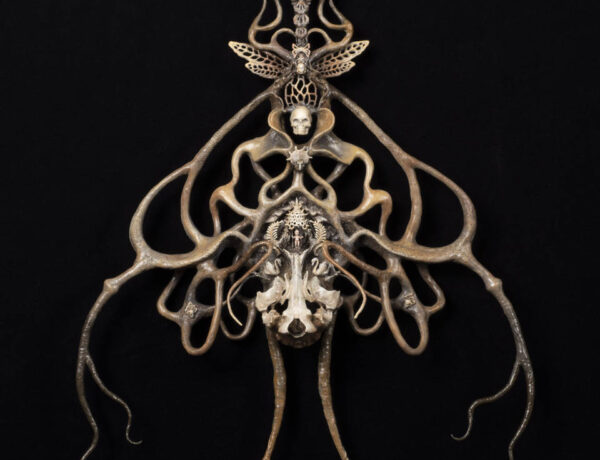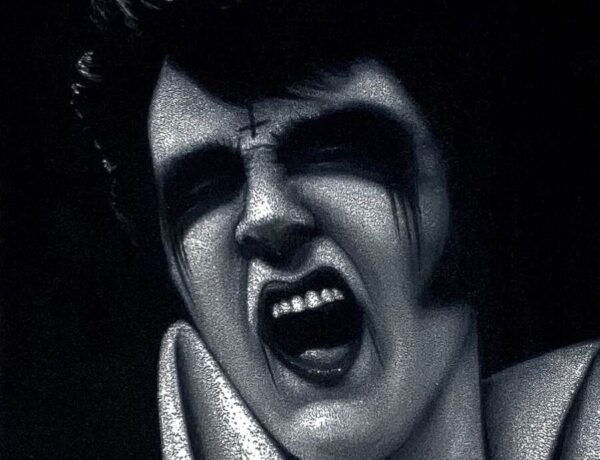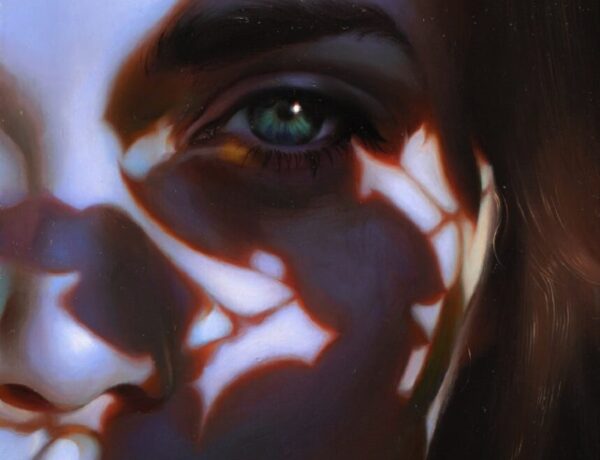There is a certain sacrality that is present within an artist’s studio space. The studio, more often than not, is a private space in which an artist can learn, grow and reflect away from prying eyes. No matter whether it’s clean, messy, big or small, these spaces offer beautifully raw manifestations of an artist’s inner world where they can be their most vulnerable selves and offer every part of themselves and their ideas to the canvas.
Being invited into an artist’s studio feels like a great privilege so imagine my excitement when Australian oil painter Jennifer Allnutt very kindly offered our readers the opportunity to take a virtual tour of her Brisbane based home studio!
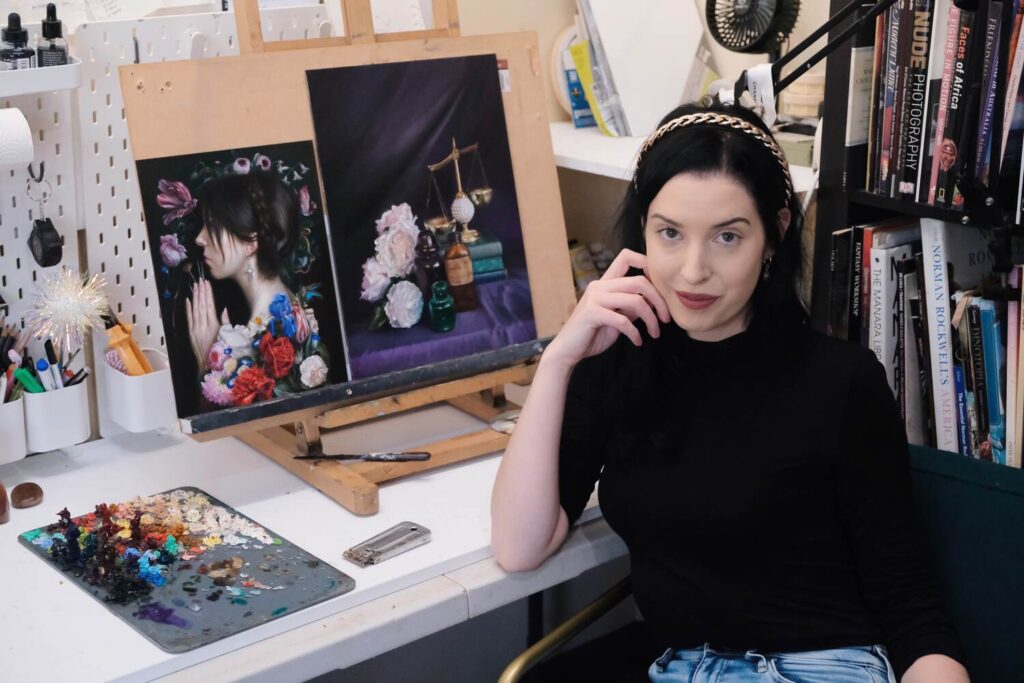
Jennifer Allnutt is best known for her works of dark surrealism in which she combines portraiture, botanical motifs and still life to create works that explore themes of the unconscious mind, transformation, the uncanny and identity. Art has played a continuously and vital role within Jenny’s life as this interest was nurtured by her grandfather and further nourished in 2007 when she would discover her love for oil painting.
With a BA in Visual Arts and a Masters in teaching, Jennifer’s passion for art has only continued to blossom well into her adulthood. The greenhouse in which her creativity blooms like the flora in her paintings is her home studio, a room within her apartment that has been transformed into her own artistic sanctuary. Join me, as I catch up with Jenny to learn all about her studio and what makes it unique to herself and her practice.
I believe it is important to make your space as enticing as possible. It has to be a cosy place that you enjoy being in.
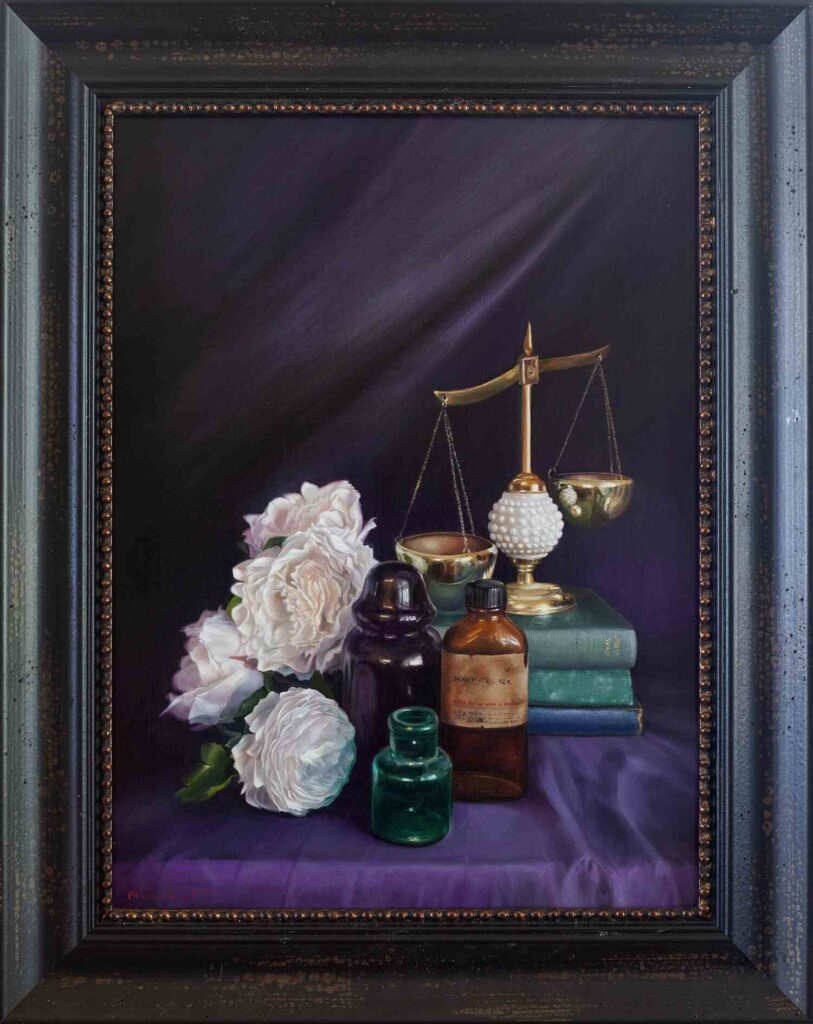
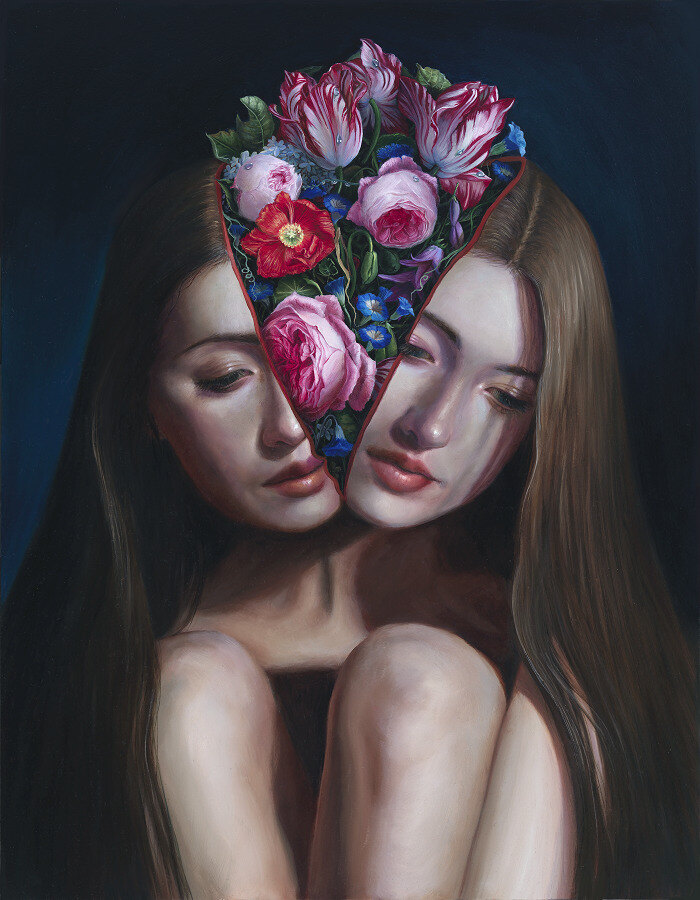
Interview with Jennifer Allnutt
Thank you so much for letting our readers get a behind the scenes look into your studio space! Can you tell me a bit about your studio and what kind of set up you have?
My current studio space is a humble, back room in our flat which also masquerades as our library and includes my clothing closet! It is a work in progress, but I am so pleased to have a space to make my own. As I sit here now, I have several still life set ups including a life size skeleton reclining dramatically. I have multiple sets of draws filled with sketchbooks, art prints, merch, packing materials and tools. On my desk is my glass palette covered in old paint, my brush tray with linseed oil, papers of reference imagery littered around, to paint a picture of the scene.
For a while I had no studio and was reduced to painting on my desk, the floor or the bed. I think as artists we tend to make do with our circumstances and a physical studio space doesn’t necessitate art but it certainly helps it grow. I believe it is like putting a fish in a tiny bowl of water, it will remain that size without change however if you put it in a larger tank, it will grow and grow. I think artists are the same and studios can really help an artist expand physically and metaphorically in their work.
I mostly sit down to paint so I use a desk easel and have a comfy chair that can spin and roll to help me get back from my work easily. I sit cross legged when I work or in a crouching position (similar to ‘L’ from Deathnote!) as I find it does help me think and concentrate better!
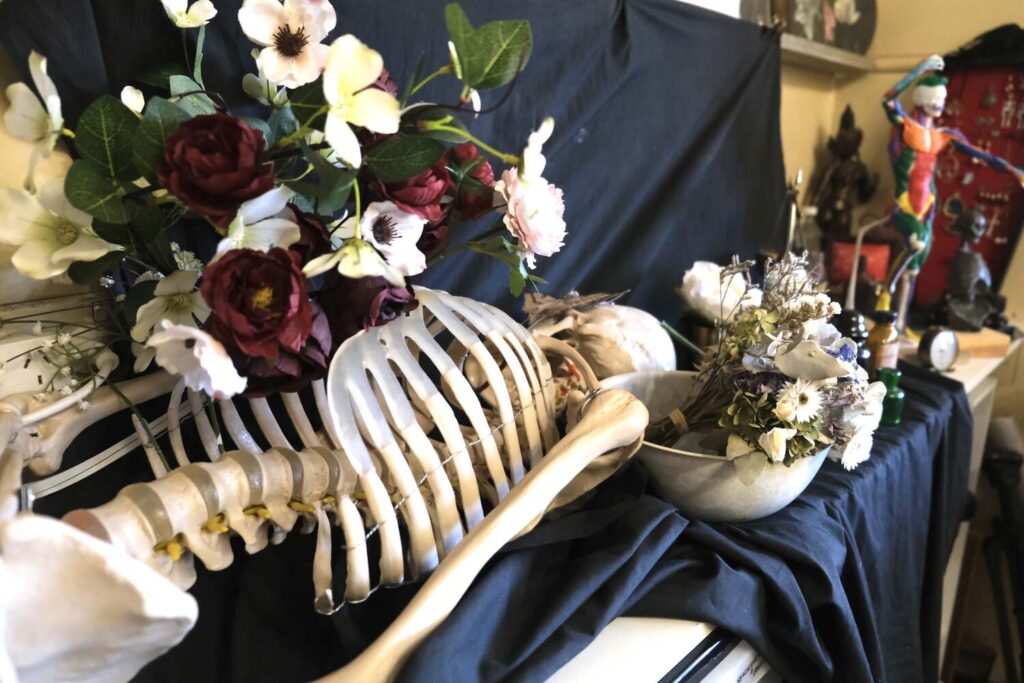

What are three things you couldn’t live without as a practicing artist?
This is a tricky question, so I chose three things which are perhaps unusual first choices but play an important role in my process!
Tea and coffee = reflection time
I love walking into the studio with a cup of tea or coffee and sitting down to work. I find the ritual comforting and conducive to getting into the necessary headspace to create artwork and truly concentrate. It may be a small thing, but I do it frequently while painting; have a sip of my drink and reflect on the progress. Even the habit of going to the kitchen and boiling the kettle for another cup is essential.
During this time, I can step away from the painting and reflect on what I’m doing. I think reflection is exceptionally important as an artist. Then when I return to the studio, I can see my work with ‘fresh eyes’ and things will jump out at me that need improvement and I’ll get back to it with ease.
Audible = getting into flow state
Listening to stories has been a game changer in the studio. By limiting myself to only listening to books when I am in the studio, it makes it an enticing prospect to enter my space and get to work! I find that these stories can often feed into my art practice too.
Audible has been the predominant entertainment in the studio but sometimes I play old movies on Netflix in the background for noise, and occasionally podcasts or my favourite music. It is rare for me to sit in silence in the studio, and I find the noise helps me to get into the flow state easier. However, every once and a while I’ll start painting and an hour will pass, and I realise I’ve been in silence without knowing it! Some days are easier than others to get into the flow. I believe it is important to make your space as enticing as possible. It has to be a cosy place that you enjoy being in.
Whiteboards = organisation
There’s a lot of things artists can’t live without but the last big, idiosyncratic one for me is whiteboards for organisation! I have a weekly and a monthly whiteboard calendar that I update regularly with deadlines. At one stage I also had colour coded (pink for most urgent to blue for upcoming) post it notes with various shows and competitions on a cork board. I find this useful as a painter because I have to factor in extra time before a deadline for drying times, varnishing, photography, framing and then shipping.
I find by physically writing things down this better helps my recollection. Also, if I lock in time on my weekly calendar as studio time, I’m less likely to sacrifice that time for other commitments. And it is so important to be selfish about your studio time as an artist with the amounts of distractions there are these days.
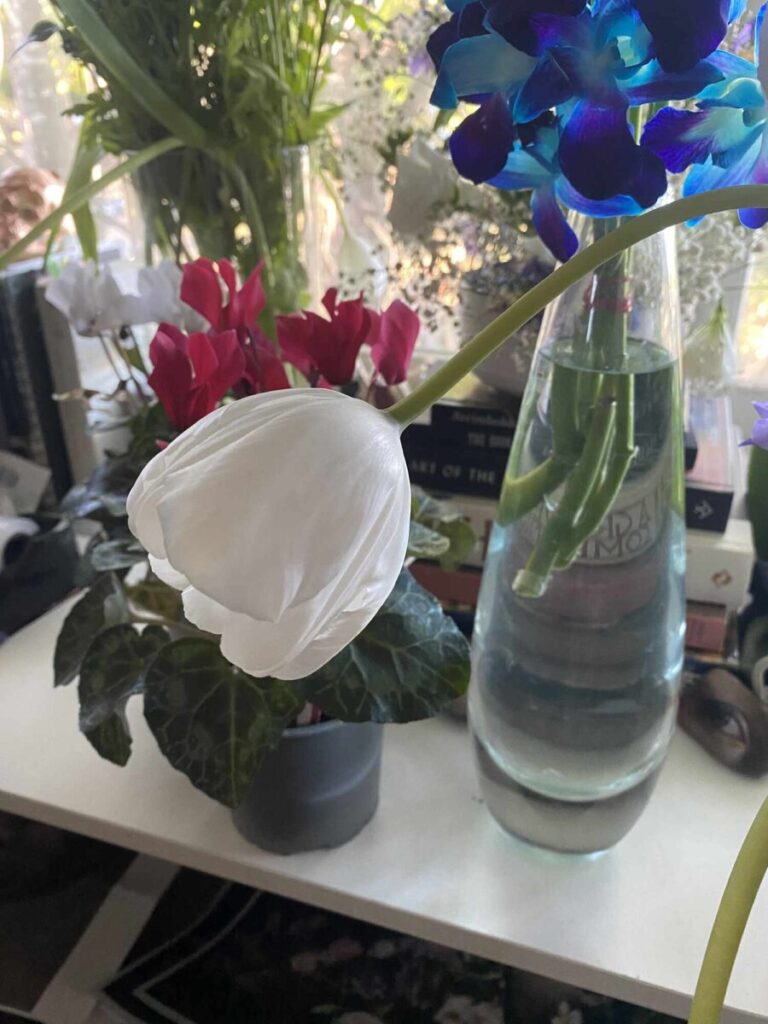


Tell me about the materials you use. Do you have any favourite go-to brands?
My absolute go to brand is Michael Harding Oil colours. In art school I started out with Art Spectrum and Windsor and Newton, and I still own some of these colours but through the years I’ve begun collecting and replacing colours with the brands Michael Harding, Gamblin and Langridge. I’ve always been a bit of a collector and every time I have some money saved up or sell a painting, I usually treat myself to a tube of paint! Art stores really are my candy stores! I dream of collecting some of the really rare pigments like Lapis Lazuli and Rose Madder because, for me, they would be like adding jewels to my paintings!
For my surfaces I primarily use ACM (Aluminium Composite Panel) or wood panel in peculiar shapes! I use these materials because from my research metal and wood are suggested to last the longest without cracking, among other things. As a traditional craft person and painter, I think it is important to do the best we can with the knowledge we have to provide something that will survive multiple generations in a collector’s family!
When I buy pre-prepared, I adore the American art supply store Trekell Art Supplies for their unique surfaces and grounds because they are prepared to a high quality! However, living in Australia the postage cost can be tough, so I’ve found alternatives locally that work and my partner who is also an artist, Scott Breton, prepares most of my aluminium panels these days!
When it comes to brushes, I’m not much of a connoisseur but I do prefer to buy the brand Neef. Occasionally I do buy brush sets from my favourite artists as a treat; I have a set by Mab Graves and Sean Cheetham which are well loved! Unfortunately, I’m not sponsored by any of these brands, they are just my personal favourites from trial and error!
I love walking into the studio with a cup of tea or coffee and sitting down to work. I find the ritual comforting and conducive to getting into the necessary headspace to create artwork and truly concentrate.
How do you prep your surface?
I mostly use pre-prepared surfaces when I can from trusted brands. Occasionally, I will buy and cut my own timber to paint on, but this can be a laborious process of sanding, sealing, priming, sanding and so on so forth! Until the surface is smooth enough. I do often add a neutral grey ground to work on as I find it less harsh than white.
Most recently my partner has started preparing his own aluminium composite panels with our favourite ‘non absorbent primer’ by Michael Harding and he creates a beautiful smooth surface that still has a slight bit of tooth for the paint. From our research into surfaces and preparation this is one of the best surfaces and grounds in terms of longevity.


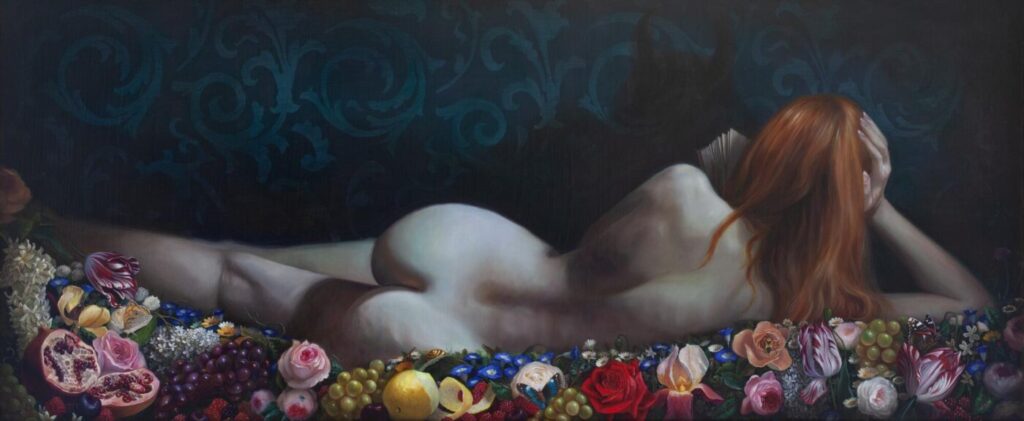
I imagine organising an exhibition can be stressful and at times, quite messy! How do you approach preparing for a new exhibition and how do you keep yourself and your workspace organised during these periods?
At the moment I’m still in the early stages of preparing for my next exhibition, I only have a few new artworks started and a few finished for other commitments. When it comes to organising for a solo exhibition, I like to write it down on a whiteboard or pin up a timetable with milestones I need to achieve by a certain time. I know there are many apps for organising yourself, but I’ve found them ineffective for me. I prefer a constant visual reminder in my studio that I can refer back to at a glance without having to open my phone and get distracted!
I often procrastinate by cleaning my studio before I start and spend a bit of time in the space arranging objects or doing arbitrary tasks to warm myself up! So generally speaking, my space is kept relatively tidy and organised due to these habits. All that being said, in the final months before an exhibition, many of these good habits fall to the wayside!
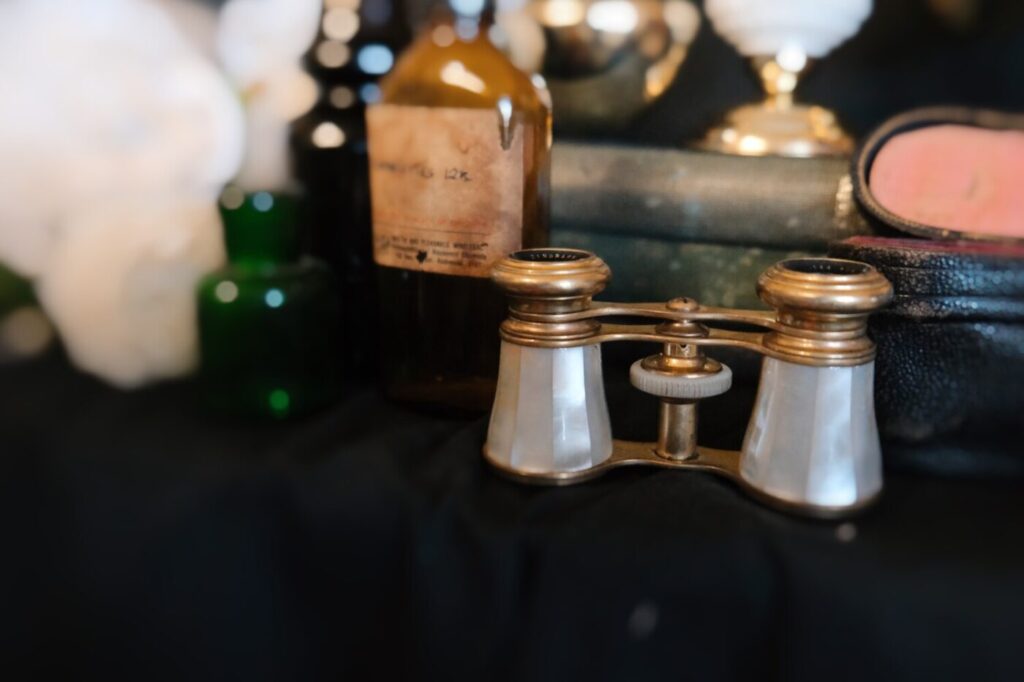
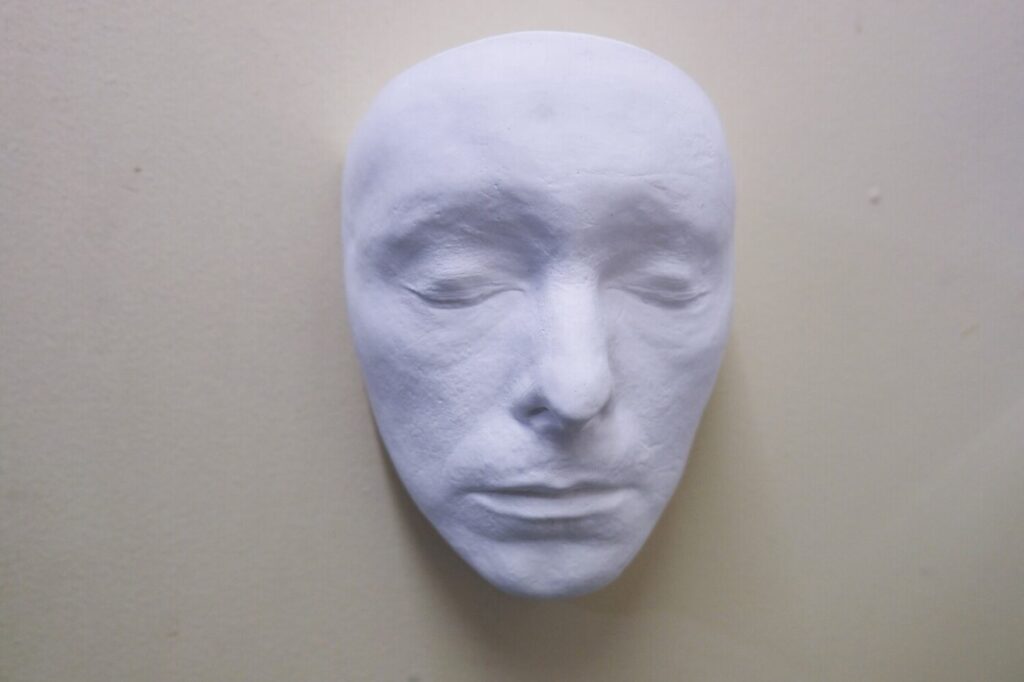
Do you keep any books, personal items, inspiring artworks, etc, in your studio space?
One of my favourite items in my studio is a gift from my partner of a plaster death mask of David Bowie! He hangs up on the wall to my left when I am at my desk and I suppose I think of him as my studio guardian angel, watching over me as I work! I remember the day he died, when I found out the news I was absolutely wailing in despair. He has always been special to me, someone to aspire to and a true artist. Another favourite is my grandfather’s antique opera glasses with mother of pearl detailing. I also have prints and artworks by Femke Hiemstra, Ash Darq, Luke Rion and Ravi Zupa.
As I said earlier, we have quite a library collection of art books and they provide endless inspiration! I like to surround myself with beautiful objects and things to my taste and you never know when they might trigger a painting! I also have a large toy spider-Halloween decoration hanging up on the window who I have named Bonaparte and many other odd trinkets that I have inherited or been gifted. In a similar way that fashion can be a way to express yourself and your identity; an artist’s studio while being practical also can be about their individual self expression.
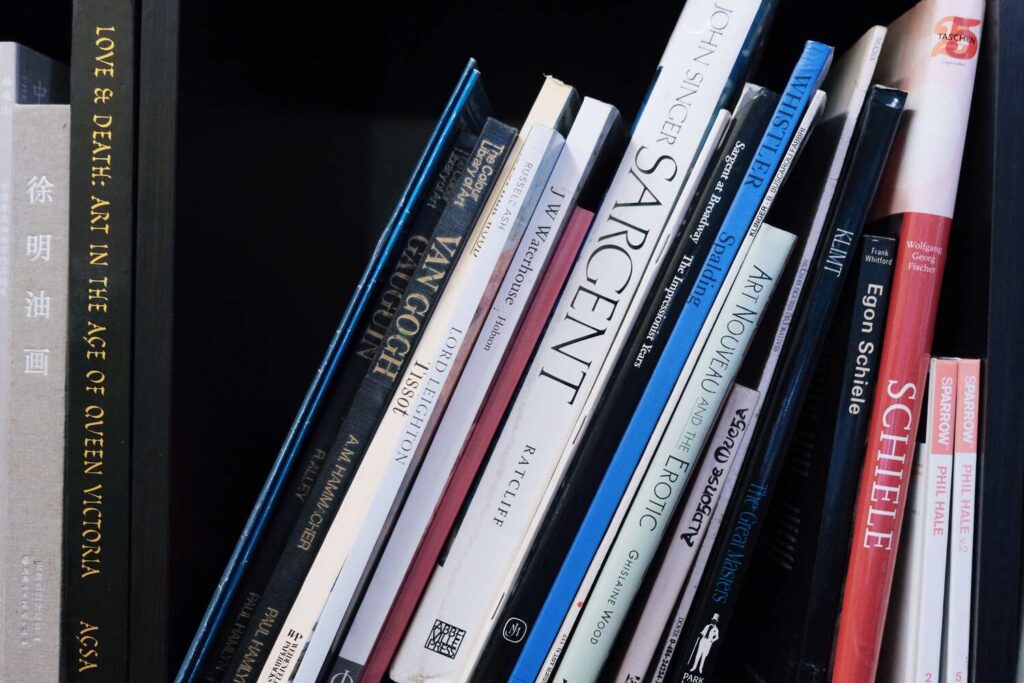

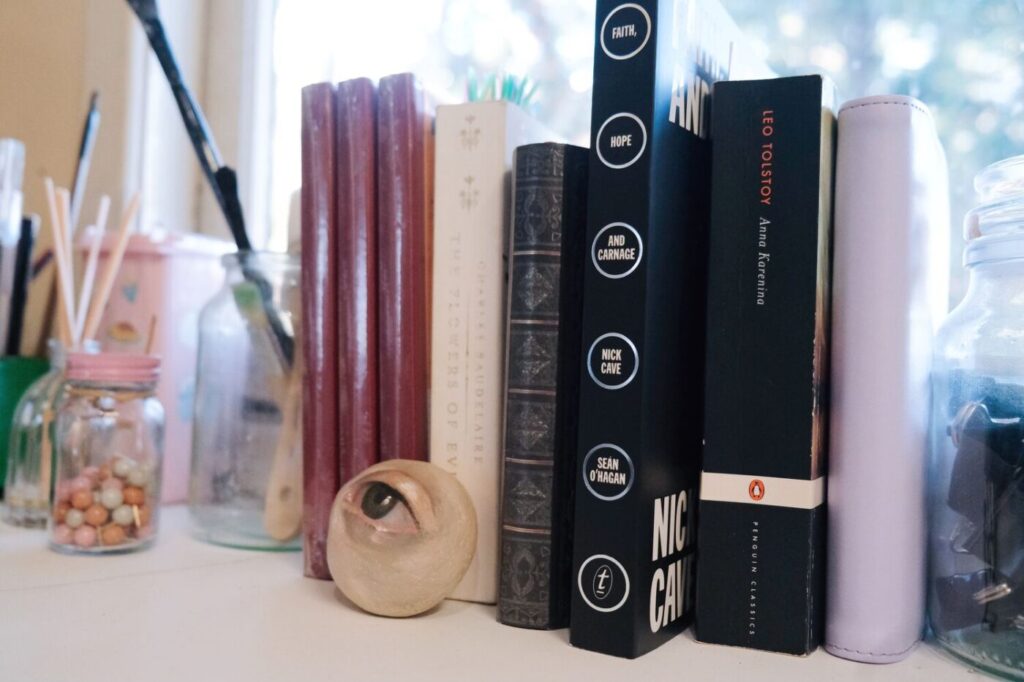
How do you prepare yourself mentally for starting on a new piece? Do you have any rituals you do to help you get in the mindset for working on a new piece?
To prepare myself at the very beginning, I enjoy looking to the past where my interests lie, whether that be literature, poetry or visual art. On top of that, I often have a thousand notes or thumbnail sketches as well that come to me at odd times and I jot down manically. This could be inspiration from movies, music, conversations and books. So, I collect lots of inspiration like a bird crafting its nest and let it simmer in my head for a period of time.
I believe the unconscious mind has a power to jumble all the imagery we inject into our minds and then arrange it in a pleasing and unexpected way, if we let it simmer long enough! Once I have a fairly solid idea, I find that I am desperate to start it, to the point I am grumpy if I am kept away from the studio! However, I always leave gaps for myself in my idea, to be open to changes and details revealing themselves to me through the process.
In terms of rituals for a new piece, these are precisely the same as every day I begin in the studio. I believe a degree of routine is important for creativity. A standard day begins with an early start, comfy painting clothes, tea or coffee, emails/organisation done, and then I can lay out fresh paint and begin listening to my current book.
The final little ritual I sometimes perform right before the brush hits the surface, is a prayer to the muses. So, traditionally the invocation or prayer to the heavenly muse at the outset of an artistic endeavour was a commonplace convention of classical poetry. Many poets, including Homer, Virgil and Milton would begin their works with a word of prayer to confess their limited capacity and humble themselves before the divine.
I find the concept of praying to the muses comforting in that the inspiration is seen as an entity rather than being born within me and my job is just to express the idea as it comes to me. Usually, I say a quiet word in my head as a nod to this traditional practice before I begin painting. I enjoy the connection to obscure past traditions.
Can we have a sneak peek on what you are currently working on in the studio?
I have two works in their final stages that I’m working on at the moment. A still life inspired by apothecary and alchemy and the other is a self portrait in prayer to the muses and engulfed in flowers. I hope to show them in some galleries soon, but you will have to follow my social media to see where they end up!
